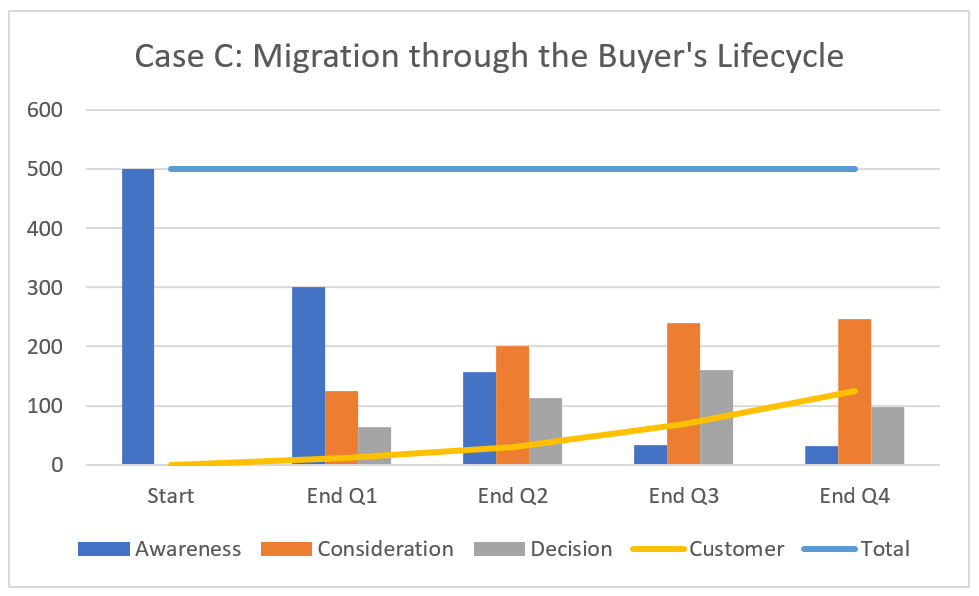This series of blogs started with an introductory article on the returns on investment from email marketing, widely reported to have the potential to be as much as 3,800%. However, I stressed these kinds of returns would remain out of reach for all except an elite of digital marketers and, in order to join the elite, the best practices for all elements of email marketing must be achieved. In this, the third of a five-part series, I'm going to focus on the planning and strategy components for successful email marketing.
Introduction: Office Products Resellers and the Importance of Email Marketing
- Part 1 - Contact lists, organizing and segmentation
- Part 2 - The foundation - buyer personas and the buyers journey
- Part 3 - Planning campaigns and strategy
- Part 4 - Execution - automation and workflows
- Part 5 - Goal setting and measuring ROI
Planning:
First, remember, one size does not fit all. Email campaigns must be tailored to fit the audience so (once the contact list is intelligently segmented) it becomes possible to target each segment with the right content, in the right place, at the right time. The marketing efforts will then be more likely to enjoy higher levels of engagement.
Organizing the "content" library according to persona and the buyer's journey (or lifecycle stage) is a fundamental component of the email marketing planning stage. Remember, the objective is to engage with the audience. Engagement means "opens", "clicks", and "conversions" with, ultimately, it all being about the last on the list - conversions! There's no point bragging about 40% open rates if you have 0% conversions.
A conversion occurs after a member of the audience opens an email, clicks on a call-to-action, and then fills in a form providing the information you want in exchange for the content you're providing. This will only occur if the content is relevant and deemed to have value by individual members of the contact list. Furthermore, the conversion step (the desired outcome) can only occur if the first two steps (open and click) have been successfully accomplished. Because the members of the contact list have different interests and requirements, poor segmentation and poor content mapping will unavoidably lead to poor engagement and poor conversion rates.
| Case | Quantity | Delivered | % | Opened | % | Clicked | % | Conversions | % |
| A | 500 | 338 | 75% | 50 | 15% | 0 | 0% | 0 | 0% |
| B | 500 | 450 | 90% | 113 | 25% | 23 | 20% | 6 | 25% |
| C | 500 | 500 | 100% | 225 | 45% | 68 | 30% | 24 | 35% |
- Case A: an unsophisticated marketer email blasting a stale list with no calls-to-action
- Case B: a marketer understanding the basics with CTAs and a conversion strategy
- Case C: a marketing expert in list segmentation, list management, and content offers
The Case A marketer may send out two emails a week and never achieve any events toward a desired outcome.
The Case B marketer may send out two emails every week, achieving 624 conversions (6 [conversions] x 2 [per week] x 52 [weeks per year] = 624) through the 12 month period. If 5% of these conversions can be turned into new customers that's 31 new customers or 6% of the leads.
Case C tells a story at a different level altogether - using the same number of contacts and the same email frequency, there will be 2,496 conversion events (24 x 2 x 52 = 2,496) and, if the same percentage as Case B (5%) are converted to customers, that's 125 new customers or 25% of the leads the campaign strategy was targeted at.
| Awareness | Consideration | Decision | Customer | Total | |
| Start | 500 | 0 | 0 | 0 | 500 |
| End Q1 | 301 | 125 | 63 | 11 | 500 |
| End Q2 | 157 | 200 | 113 | 30 | 500 |
| End Q3 | 33 | 239 | 160 | 68 | 500 |
| End Q4 | 31 | 247 | 97 | 125 | 500 |
In the Case C example there have been nearly 2,500 conversion events on 52,000 individual email "sends" over a 12-month period resulting in a final conversion rate of 4.8%. To accomplish this it required 100% delivery rate, 45% open rate, 30% click rate and 35% conversion rate. Conversion rates of these levels can only be achieved by elite email marketers, not only requiring great tactics, planning and strategy, but also, great content timed to match each of the individual contacts current position in the journey through the buyer's lifecycle stages.

Strategy:
Once a marketer has built a high-quality library of content offers and deployed technology for contact management [including the use of automated list segmentation updates as dictated by opens, clicks and conversions] a well-considered email marketing strategy is the next step necessary for extracting the most value from the content and the highest returns from the effort.
- Smaller batch quantities of highly targeted emails
- It takes time and effort to prepare different email content targeted at different personas in different stages of the buying cycle. However, as the example above should have demonstrated, it will result in better outcomes than mass launches of generic emails.
- Delivery according to local time zones
- Depending on where the target audience is located this capability becomes an important factor. Sending an email at 8.00AM on the East Coast to a recipient on the West Coast with a 3 hour time difference may not be the optimum time for the West Coast contact. This poor delivery timing will be reflected in reduced open, click and conversion rates.
- Content sent to a relevant audience at the right time
- I don't think much more should need to be said on this! But ... to reinforce the point, sending special offers, discount coupons, etc. on random products to contacts that are still in the awareness stage of the buying cycle, is a misplaced, counter-productive strategy.
- Launch frequency monitoring and adjustments to match contact preferences
- We all already receive far more email than we can handle and there's nothing worse than getting bombarded with too many marketing emails from a source you've signed up with, with high hopes for informative, relevant, and timely content. For the sender to accomplish the optimum balance between too much and too little, it will take constant monitoring and adjustments of schedules and frequency to best suit the preferences of the audience. Failure to do so will lead to spam reports and opt-out's. The best email marketing strategies must incorporate time for analysis and fine-tuning.
- Smart forms incorporating progressive profiling
- Some contacts may complete multiple forms in exchange for various content offers through the nurturing process and the shorter the form the more likely it will be submitted. The use of technology, to enable "smart" and "progressive profiling" fields, allows a more complete profile of the lead to be built over time. This can be accomplished without showing a lengthy form that's more likely to deter and lead to a lost conversion opportunity.
- Tactics for nurturing through the three stages of the buyer's journey
- Have additional offers in the lead nurturing pipeline to facilitate moving a lead from one stage in the buyer's journey to the next. If a contact in the awareness stage shows interest by downloading a piece of educational content, then the "thank-you" page should contain a related offer that's targeted more at the consideration stage. If your educational content does it's job then the consideration content is more likely to become relevant to the lead.
- High-quality content offers
- Content is King! Again, no more should need to be said! To capture a lead through a conversion the visitor is giving up personal information. He or she knows this means they will be the target of additional marketing materials and, if the content isn't judged to be worth the exchange, then the conversion will either not occur in the first place or it will be the subject of a rapid "opt-out" later.
- Personalization
- We already talked about the importance of a clean contact database, no misspelling, correct capitalization, etc. Once this is accomplished, leveraging first names to personalize email can become an important factor for optimizing open rates.
- Follow up
- If This Then That (ITTT). So, you've sent an email, it was opened, it was clicked and your form was completed and submitted. Congratulations - a major goal was achieved. But ... what next? If you don't have a plan, and you don't have a workflow, then your nurturing process stalls and the lead you worked so hard for flounders in your sales funnel.
- Lead replenishment from blogging, social media and referrals from evangelists
- In the Case C example used in this blog nearly 95% of the contacts were moved out of the awareness stage and deeper into the buyer's journey. Unless there's a strategy to replenish leads through the use of blogging and social media tactics, then the sales funnel will empty over time.
Conclusion:
Anybody can randomly blast an email contact list with poorly conceived content but it's unlikely to provide much of a return. The average email list decays at 20%+ per year. A contact list targeted with no thought to strategy or content quality will decay much faster.
There are rarely any silver-bullet solutions. Doing something well means working hard and thinking carefully about what's being done. Effective email marketing requires intelligent effort and it requires a library of content - both of these mean time and effort have to be invested.
The common perception may be that email is old school and social media is the way to go. However, for marketers prepared to invest the necessary effort, there's the potential to join the elite and earn significant returns. Getting a well targeted email directly into an inbox still beats social media engagement rates hands down thereby ensuring there remains an important place for email in modern-day digital marketing.
There's an email strategy for office products resellers that can make a difference over time but it requires hard work, the use of technology, and an ongoing, consistent effort.
Learn how the aftermarket industry has failed the independent office products resellers, its own failure to understand the digital revolution, and the impact that's now having on the industry. Our free e-book casts a critical look on the industry shortcomings.









